Letters from Lodi
An insightful and objective look at viticulture and winemaking from the Lodi
Appellation and the growers and vintners behind these crafts. Told from the
perspective of multi-award winning wine journalist, Randy Caparoso.
What Lodi can do to slow down the loss of old vine plantings
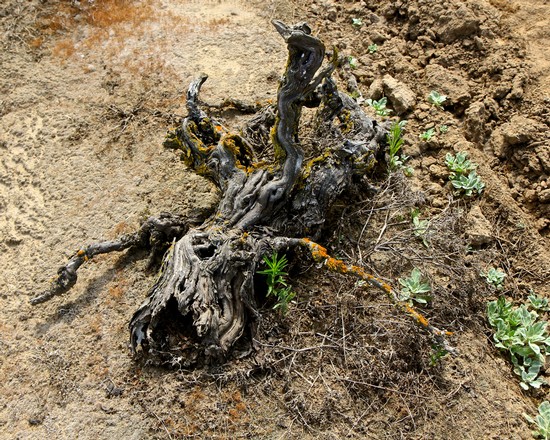
Another one bites Lodi's sandy dust; dead ancient vine Zinfandel (planted in early 1900s) in Lodi's Noma Ranch
A continuation of our previous post, Last rites for Lodi's old vine growths
It’s a good time to enjoy good ol’ old vine Zinfandel. There’s a little bit of chill in the air, leaves are turning color, and the mind drifts off into memories of brown spices, baking pies, stews on the stove, bread in the oven, ugly sweaters.
But enjoy those wines while you can; because – as we mentioned in a previous post, Last Rites for Lodi’s Old Vine Growths – decently priced old vine Zinfandel grown in Lodi (the home of more old vine plantings than anywhere else in California) is disappearing as we speak.
Which begs the questions: Why is that, and what can be done to prevent such a calamity? Last month, Kevin Phillips – Vice President of Operations for Michael David Winery and its viticultural arm, Phillips Farms – sounded the alarm. Old vine plantings (which we define as vines more than 50 years old) in Lodi are routinely pulled out after every harvest. However, this year there will be a lot more removal of old vines because of decreased market demand for the grapes – due particularly to the steady decline in sales of White Zinfandel (yes, a lot of Lodi’s old vine Zinfandels have been going into fruity pink wines) as well as in red Zinfandels priced under $10.
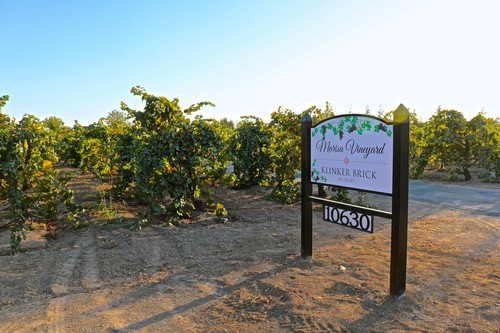
Klinker Brick's Marisa Vineyard (planted in late 1920s) is one the few ancient vine Lodi Zinfandel plantings clearly marked by a roadside sign
“Growers are doing what is the most economically productive thing they can do,” says Phillips. Robert Lauchland, one of Lodi’s most widely respected growers and producers, fully acknowledges the reasons why he’s pulling out the last acre of 85-year-old Zinfandel that has been going into McCay Cellars’ most prestigious wine, their Contention Zinfandel, selling for $64/bottle. Never mind that this measly acre (less than an acre, in fact) is, according to Lauchland, “the last connection to my grandfather.” Or that it was part of the original seven vineyards going into the “7 Deadly Zins” that made Michael David Winery famous, and that Michael McCay is still willing to pay any amount of money for the 3 tons (a very acceptable yield for vines of this age) that this shriveling block of gnarly vines still yields.
The reason why Lauchland is pulling out the last of his historic vines? Two words: Cabernet Sauvignon. Once he replaces the remnant of his grandfather’s head-trained Contention vines with trellised, machine pruned and harvested Cabernet Sauvignon, he will be able to reap more than twice the revenue, at well less than half the cost of farming it. The removal of old vine Zinfandel, says Lauchland, is an “unfortunate market correction.”
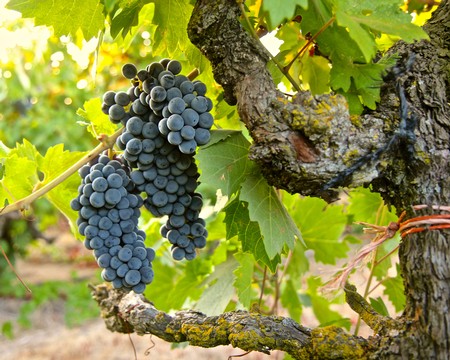
Zinfandel clusters in Harney Lane's 113-year-old Lizzy James Vineyard
This is cause for concern. What Kevin Phillips fears is not so much the loss of 1 acre, but rather the impending loss of substantially larger blocks of acreage going under the knife of a vine digger. He is also resigned to the fact that the old vines slated for removal in the fall of 2017 are going out, no matter what. He is more concerned about pro-active measures we should take to slow down this trend in the years to come.
Says Phillips: “What can we do? We can start by forming a closer partnership with organizations like the Historic Vineyard Society and ZAP (Zinfandel Advocates & Producers) to document all the existing old vine vineyards in Lodi – and we need to do this sooner rather than later. Identifying vineyards may help growers pair up with wineries looking for fruit from appropriate blocks; if the fruit is available, of course.
“Smaller wineries, for instance, may need only 1 to 5 tons, so small blocks in old vine plantings are ideal for them. Bigger wineries may be looking 25 to 50 tons. Maybe they’ll be looking for spicier Zinfandel; in which case old vine vineyards on the west side of Lodi would be appropriate for them. If we create a database – showing age of vines, acreage, expected tons, location, grower contact information, etc. – we can establish an outlet to help market these vineyards on an individual basis. Then we can get this information posted on industry bulletin boards followed by the wineries, such as Wine Business Monthly or Lewis Perdue’s Wine Industry Insight.”
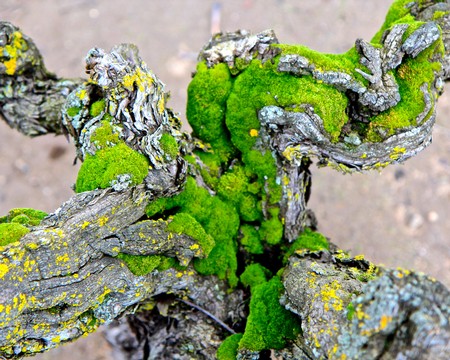
Over 100 years of lichen and moss built up on Soucie Vineyard Zinfandel (one of Michael David's original "7 Deadly Zins" growths)
This brings up the question, who would be the “we” compiling all this information? Last week the Executive Board of the Lodi District Grape Growers Association (LDGGA) came together, and one of the topics addressed was Lodi’s continuous loss of heritage plantings. According to LDGGA’s Executive Director Amy Blagg: “We realize that increased pull-outs of head-trained vines is part of the cyclical nature of agriculture, and the decisions growers face are difficult ones. To break this cycle, we think we need to do more to promote Lodi’s old vine Zinfandel, its history, and what makes these vineyards special.”
Blagg goes on to suggest: “Perhaps LDGGA and the Lodi Winegrape Commission can coordinate a survey to compile a history of the region’s historic plantings. On our part, we can share family stories, the unique qualities, and help our consumers better connect with the old vines that make Lodi special. The mission of LDGGA is to work with elected officials and share the impact of legislation and regulation. We can work with elected officials to show how the laws and regulations they impose directly influence the availability and cost of labor, thereby exerting these changes in our agricultural landscape. We can share how policies such as the Estate Tax, for example, impede families from passing on properties from generation to generation.”
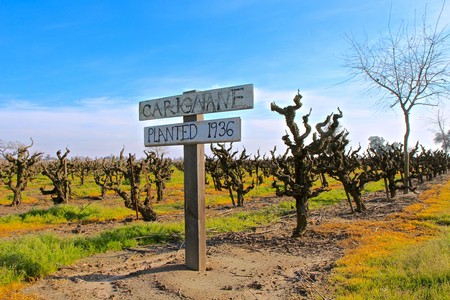
Own-rooted 81-year-old Carignan in Lodi's Bishofberger Vineyard
Six more ideas that might help slow down the loss of old vines:
1. Establish a map available to both the industry and consumers pinpointing the location and boundaries of all of Lodi’s significant old vine plantings. Regional vineyard maps designed by satellite imagery, after all, are already done in all of the major wine regions on the West Coast, from Washington and Oregon's Willamette Valley all the way down to Santa Barbara. Why not Lodi? If Lodi wants to be recognized for special vineyards, why should we not recognize them on a map, the same way it is done all over the world?
2. What about finally defining what “old vine” means? Because the term is unregulated, “old vine” has been applied to wines made from vineyards that are barely 25, 30 years old (which is considered “young” in Lodi). Taking a cue from Australia’s Barossa Old Vine Charter, here in Lodi we might want to delineate old vine plantings by proposing our own wine label designations, such as this:
Old Vine – 50 years or older
Heritage Vine – 75 years or older
Ancient Vine – 100 years or older
Historic Vine – 125 years or older
By this reckoning, the implication is that “old vine” should be a lower tier in this hierarchy. Shouldn’t vines more than 80 or 100 years old be celebrated more? There should also be a threshold: at least 90% of the grapes going into a bottle must come from the vineyard of note (for example, a wine that is blended with 12% Petite Sirah from a much younger vineyard would not be eligible for a special vine-age designation). Whatever the case, the Lodi Viticultural Area might seriously consider taking the lead with its own voluntary “Charter,” “Code” or “Seal.”
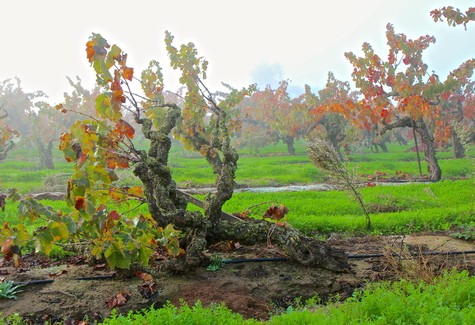
Down for the count: 127-year-old Carignan in Jessie's Grove
3. Revenue, of course, is the 800-pound gorilla. Old vines in every part of the world are notoriously lower yielding. Perhaps it might be time that old vine growers come together to discuss alternative means of making old vine plantings economically viable. In Willamette Valley, for instance, there are a number of Pinot Noir growers and producers who agree to purchase fruit priced by the acre rather than tonnage. This collaborative effort – wineries willing to compensate growers for quality rather than quantity of fruit – is one reason why Willamette Valley has become such a prestigious wine region. Maybe it’s time that Lodi’s old vines got their due.
4. We have recently proposed a yearly event called ZinTech – a Zinfandel Technical Conference, in which Zinfandel growers and specialty winemakers, as well as media and trade, plus consumers from all over the state (and beyond) come together to taste, discuss, self-assess, and learn more about Zinfandel viticulture and winemaking. If there is any region in California where this should happen, it should be in Lodi, where more than 40 percent of the entire state’s Zinfandel is crushed each year. Lodi should own Zinfandel.
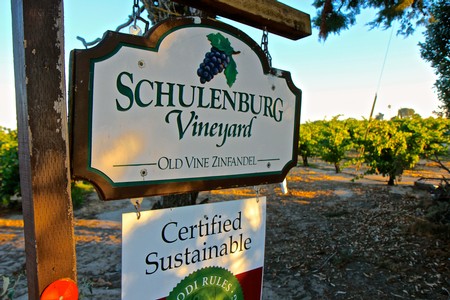
Schulenburg Vineyard; west side Lodi Zinfandel planted in the early 1950s
5. Dr. Stephanie Bolton – Lodi Winegrape Commission’s Director of Grower Communications & Sustainable Winegrowing – has suggested a yearly “Old Vine Picnic,” when growers, retail and restaurant buyers, consumers and the entire Lodi community come together to celebrate Lodi’s heritage vines. The owners and farmers who cultivate these plantings, after all, are truly doing heroic work. And it’s not with just Zinfandel – Lodi’s heritage plantings are also replete with Carignan, Grenache, Barbera, Alicante Bouschet, Cinsaut, and even the region’s most historic grape of all, Flame Tokay. Lots to celebrate – preferably with food, in the great outdoors!
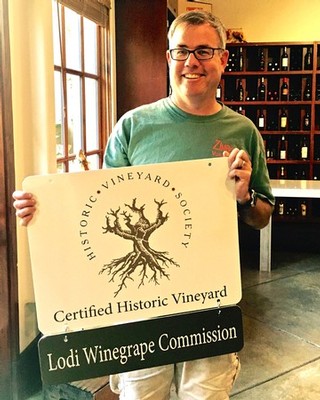
Lodi Winegrape Commission Program Director Stuart Spencer with Historic Vineyard Society sign, which Dr. Stephanie Bolton proposes attaching to signs bearing names of individual Lodi heritage vineyards, marking each site
6. Vineyard signs – also according to Dr. Bolton, Lodi’s old vine vineyards should be well marked, possibly with the names of each vineyard in LoCA’s orange color as well as with an official Historic Vineyard Society plate (presuming the vineyard is also registered with HVS). You do this as a matter of respect, as well as for the benefit of visitors, old vine wine lovers and the Lodi community.
7. Is it time to resurrect the old idea of grower cooperatives? This would be Lodi Zinfandel co-ops producing primarily $18, $19 wines (today's most rapidly expanding retail price category), plus smaller percentages of more premium priced wines coming from the more unique vineyards. These types of co-ops, in other words, would be completely different from the Lodi co-ops of old, which specialized in low-priced fortified wines and brandies. Good examples of this type of co-op that has worked in European countries for nearly 100 years would be Produttori del Barbaresco in Italy (which consists of some 50 families farming about 250 acres of Northern Italy's most prestigious grape, Nebbiolo), or Le Chablisienne in France (the latter, consisting of 300 growers representing some 17,000 acres of coveted Chardonnay plantings).
Lodi’s Craig Rous, who cultivates 108-year-old Zinfandel in his Rous Vineyard, boils things down for us by saying, “I believe we are at the tipping point – the crisis is upon us. ... There really is only one solution, and that is for growers of old vine Zinfandel to ‘partner up’ with wineries that recognize the value in keeping these vines in the ground.”
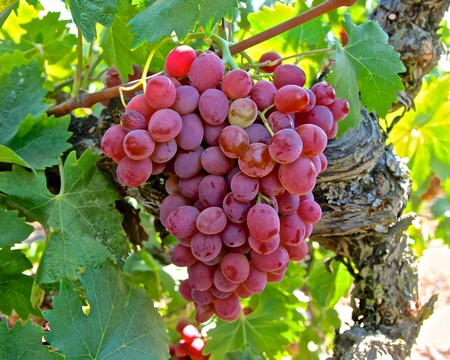
Typically stunning Flame Tokay; growing on 128-year-old ancient vine in Jessie's Grove's Royal Tee Vineyard
What Rous is talking about is more regular, yearly production of wines with prestigious, single-vineyard designations – “something growers in Napa Valley figured out a long time ago.” Rous acknowledges that “this won’t come cheaply to wineries, but it ensures stability of fruit source.” As for growers, this means “a share of the accolades,” which they’ve long deserved anyway.
The danger, according to Rous, is that “in a few short years there will be so few vineyards left that the price will be sky-high. ... The result will be very little old vine fruit available to Lodi’s smaller, family-owned wineries, and big-name producers from outside the region will swoop in to grab the best of them.”
But on a bright side, says Rous, “If growers and winemakers in Lodi can act now to get ahead of the problem, they just might be viewed as ‘saviors’ of California’s heritage grape.”
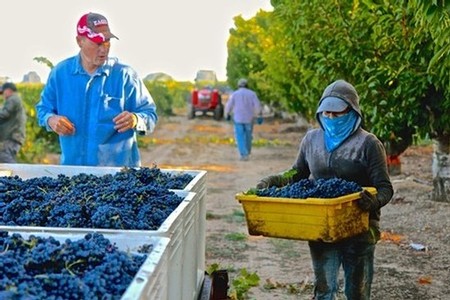
Craig Rous harvesting Zinfandel in his 108-year-old Rous Vineyard on Lodi's east side